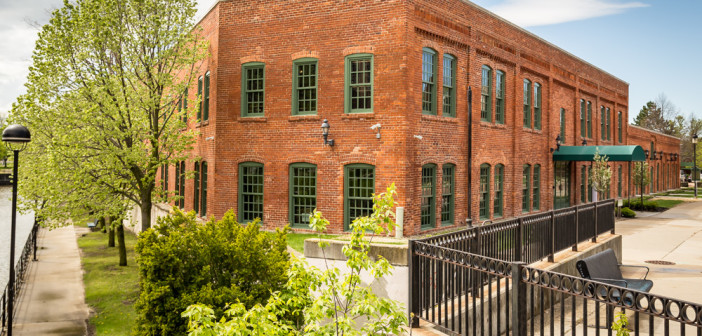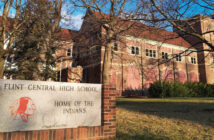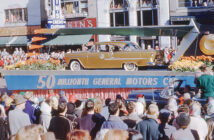The bricks of Saginaw Street, the iconic buildings, the land and people of Flint have been part of a deep and impactful history. It’s a history that has helped to shape not just the life of its citizens, but also the course of the nation and beyond.
My City Magazine presents the six biggest ways Flint changed the world.
General Motors (1908)
Obviously, right? When Billy Durant started his holding company in 1908, only he dreamed of how big it would become. General Motors grew into a juggernaut and revolutionized an entire industry. GM produced the now iconic auto brands of Buick, Chevrolet, Pontiac, Oldsmobile, GMC and more (most of which were built in Flint). In addition to vehicles, the company branched out into other production avenues. (For example, Billy Durant purchased a fledgling refrigeration company for General Motors that he named “Frigidaire” which went on to become one of the biggest names in appliances.) Through its journey, General Motors provided innovation to the world of transportation with the inventions of its engineers, most notably that of Charles Kettering.
At its highest point, GM employed more than 500,000 people worldwide (209,000 today) and that doesn’t include the jobs it created for parts suppliers and sales. GM impacted the economy and lives of people in unprecedented ways.
Want more? Without General Motors, the Chrysler Corporation may never have existed as Walter Chrysler got his start in cars with GM. Likewise, John DeLorean would never have started his company. Can you imagine Doc Brown traveling “back to the future” in anything other than a DeLorean time machine? (GM did help kill the electric rail system. Bummer. That would have been nice. Can’t win them all, I guess.)
Community Schools (1935)
In 1935, the Flint Rotary Club listened to an in-depth and passionate presentation from a Flint School physical education teacher named Frank J. Manley. The former school dropout, telephone lineman, traffic cop and construction worker had an idea. He spoke about the need for after-school and recreational programs that worked within, and in collaboration with, the community. Manley believed that the active participation of each student in all schools would help cure society’s ills and that all communities should present the same message to each child. For Manley, shared education was key. The Mott Foundation soon presented Manley with a $6,000 grant to implement his idea. Flint Community Schools were born. The community school concept would spread from Flint to the rest of the nation.
Frank J. Manley is now known as the father of the modern community school movement. He penned a book in 1960 entitled Community Schools in Action: The Flint Program that showcased the model that started it all.
The Sit-Down Strike (1936)
Another no-brainer. One can even argue that the sit-down strike was the birth of America’s prosperous middle class. It was certainly one of the first demonstrations of legal worker solidarity since the passage of the National Labor Relations Act in 1935. (Strikes have been going on since the birth of our nation, with some of the biggest happening in the copper mines of the Upper Peninsula in the mid-1800s. Up until 1935, striking workers did not have the protection of the government or law.)
In the summer of 1936, Michigan was in the middle of a heatwave and some Flint auto workers died due to heat and poor working conditions. To add to that, GM was cutting wages. Workers asked for better conditions and better wages and every plea fell on deaf ears, so they turned to the fledgling UAW leaders Wyndham Mortimer, Roy Reuther, Henry Kraus and Eric Branoff for help. GM, through the use of workforce spies, caught wind of the meetings. On December 29, UAW officials learned that GM would be removing vital dies used to make car bodies from the plants in Flint over the holidays. That knowledge led to GM workers’ refusal to leave the plant. On December 30, 1936, the sit-down strike had begun.
After 44 days, the strike ended and a new day had dawned for the nation’s workforce. UAW membership quickly rose to nearly 300,000 and American jobs became the envy of the world.
Wartime Production (1942-45)
As World War 2 began overseas, the U.S. looked on warily. As a precaution, the government began to plan for the worst. As early as 1938, Flint plants were being identified as targets of war production for our military. (This was not new – Flint plants were converted for WWI production, albeit on a smaller scale. GM and Billy Durant were awarded accommodations after the first world war.) In 1940, a deal had been struck to create $61 million worth of machine guns at the ACDelco plant. When the Japanese attacked Pearl Harbor, all auto production was halted in Flint for the next three years, making way for Roosevelt’s “Arsenal of Democracy.”
The hardworking men and women of Genesee County went to work and what they produced played a large role in the battle against fascism and the Axis powers. By the war’s end, Greater Flint had produced 11,328 Sherman Tanks, 1,190 Pershing Tanks and 4,200 Patton M-48 Tanks. The Fisher Body 1 plant produced 155mm “Long Tom” guns, 120mm anti-aircraft guns and 38-caliber guns for battleships. Buick produced 12.5 million shell casings and B-24 Bomber engines. Buick workers also produced over 2,000 of the GM-designed M-18 Hellcat Tank Destroyers. Greater Flint’s production efforts were hailed by General George S. Patton as one of the chief reasons the U.S. and Allies were victorious.
Fair Housing (1968)
In the late 1960s, Flint led the way in Civil Rights in two specific instances. In 1966, the Flint City Commission named Floyd McCree as the first African-American mayor of a major U.S. city. Then, on February 20, 1968, Flint became the first city in the nation to pass a fair housing ordinance.
In the summer of 1967, America was a hotbed of revolution. Flint was not spared. The city was highly segregated due to discriminatory housing laws and the malicious practice of redlining. The lack of an open housing ordinance became a major source of displeasure for Flint residents. An open housing ordinance was placed before the City Commission on August 14 and rejected. Mayor McCree resigned in protest stating, “I’m not going to sit up here any longer and live an equal opportunity lie.” A ten-day, sleep-in protest was organized on the lawn of Flint City Hall by Olive Beasley of the Civil Rights Commission, Woody Etherly Sr. and the Flint NAACP youth group. The sleep-in culminated in the largest civil demonstration in Flint history when over 5,000 people showed up in support. After a forced public referendum, Flint passed the fair housing ordinance by a mere 30 votes.
Following Flint’s lead, cities around the country began passing similar ordinances and in April of 1968, the U.S. Congress passed the Fair Housing Act.
Genesee County Land Bank Authority (2004)
Due to economic hardship starting in the late 1970s, the City of Flint and Genesee County were dealing with urban decline and blight at record levels. Michigan’s tax foreclosure process during this time period contributed to the problem by keeping abandoned properties off the tax roll and out of circulation for up to seven years. Genesee County fought for change because seven years is too long a time period to begin to heal. So, in 1999, a new process was unveiled, putting properties into the hands of local county treasurers after only 2.5 years.
In 2004, the State of Michigan passed land bank legislation and the Genesee County Land Bank Authority (GCLBA) was formed. The GCLBA began to use the new tax law as a community development tool to acquire abandoned land through the 2.5-year foreclosure process and use that land to help develop communities. To date, the GCLBA has demolished 11,200 blighted structures (clearing room for gardens and homeowner side lots), redeveloped close to 5,000 properties for resale, maintains over 4,100 vacant properties yearly and was instrumental in the redevelopment of Chevy Commons.
With the GCLBA as a functional model, land banks have been established in major Michigan cities and across the U.S., providing a road to progress for many impoverished municipalities.
Without Flint, the world would be a substantially different place. The past triumphs (and those to come) of our city are points of pride and should always be celebrated.








